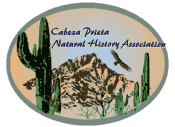
Cabeza Prieta Natural History Association
A Visitor's Guide to El Camino del Diablo
Goldwater Range northern boundary to Yuma and Interstate 8
Reset odometer
Mile 0.0. Key junction. A-16 From the intersection at Goldwater Range boundary, sign C, go north (straight ahead).
As you go.... Mile 0.1: Date palms and Gila Ranch subdivision on west (left).
As you go.... Miles 0.4 to 0.5: Smoke trees (Psorothamnus spinosus). They bloom in May or June, meaning that winter visitors may not understand the joy felt by residents who luxuriate in their indigo blooms and mystical, diaphanous form.
Mile 0.7. 32°37'12"N, 114°12'41"W. This is the Mohawk branch of the Wellton-Mohawk canal, carrying irrigation water as far as the Mohawk Mountains and feeding another canal that attends Texas Hill. Exercise caution and do not exceed 15 mph. Road makes hairpin turn to the east, then veers left and up to top of the flood control levee, from where you have a grand view of Gila River Valley. Then the road goes north.
Water in this canal flows eastward from the Colorado River and is pumped uphill at several pumping stations. This vast irrigation project began operation in 1952 and involves about 65,000 acres of farmland. According to the Bureau of Reclamation, the 18.5-mile Wellton-Mohawk Canal diverts Colorado River water from the Gila Gravity Main Canal about 15 miles below Imperial Dam. Its branches, the Wellton Canal and the Mohawk Canal, are 19.9 and 46.8 miles long respectively. The Wellton Canal has a diversion capacity of 300 cubic feet per second and the Mohawk Canal has a diversion capacity of 900 cubic feet per second. Three large pumping plants along the Wellton-Mohawk Canal lift the water a total of 170 feet. Thirteen small pumping plants are scattered throughout the Wellton-Mohawk Division on 227 laterals. There are also branches for a Texas Hill Canal and Dome Canal. The canals can be dangerous for people or wildlife, with steep slippery sides, siphons, and unpredictable currents leading to death by drowning.
Mile 1.4: Pavement.
Mile 1.5: This smaller canal is the Wellton branch of the Wellton-Mohawk Canal, delivering irrigation water as far east as Antelope Hill.
Because of the naturally salty soils, fertilizers, and high temperatures, the fields watered by these canals build up salts and must be periodically flooded to leach away the salts. That water is pumped by wells, from an average depth of about 100 feet, and that highly saline water is returned by gravity to the Colorado River main channel, near Yuma. La Cienega de Santa Clara, a 40,000-acre wetland in the Colorado Delta, depends upon this water to support a rich wildlife and bird sanctuary.
Mile 1.6: Road passes under Interstate 8.
Mile 2.3. 32°39'35"N, 114°12'37"W. Highway 80 at Avenue 25E (25E for 25 miles east of Yuma). Turn left (west) for Dome and Yuma, or right (east) for Wellton.
Railroad crossing is just before the highway stop sign. The trans-Arizona railroad reached here, Adonde, late in 1878 following years of corporate and political intrigue portrayed in David Devine's book Slavery, Scandal, and Steel Rails (iUniverse, 2004). One newspaper reported that the trip from Yuma to Adonde would take two hours and cost $3. The facilities at Adonde included a "temporary platform for delivery of freight, barber shop, two saloons, one hotel, telegraph with lady operator, Chinese wash house, railroad office, and one butcher shop." The hotel was actually a railcar with rooms and, as you may realize, the name Adonde is Spanish (Adonde or A donde) for "Where?" as in a disbelieving "Where in the world is that?" As the tracks were laid eastward, reaching Wellton on February 1, 1879, Wellton soon became the hub of local activity and a water stop for the steam engines.
As we shook off the sands of Lechuguilla on the main highway, we thought, the clocks of history have done little ticking on El Camino del Diablo since Padre Kino's time. Dorothy Childs Hogner, Westward, High, Low and Dry
- Prelude and Map
- Introduction
- Leg 1a: Ajo to junction of Darby Well Road and Highway 85
- Leg 1b: Organ Pipe to junction of Darby Well Road and Highway 85.
- Leg 2a: Darby Well Road to Tule Well
- Leg 4: Tule Well to Tacna
- Leg 2b: El Camino del Diablo, Tule Well to Tinajas Altas
- Leg 3a: Tinajas Altas to Goldwater Range northern boundary
- Goldwater Range northern boundary to Yuma and Interstate 8
- Goldwater Range northern boundary to Wellton and Interstate 8
- Leg 3b: Tinajas Altas to Fortuna and Interstate 8
- Alternate route From Leg 3b to Interstate 8
- Epilogue
Copyright Creative Commons
HTML & Programing by
Thomas R. Powell